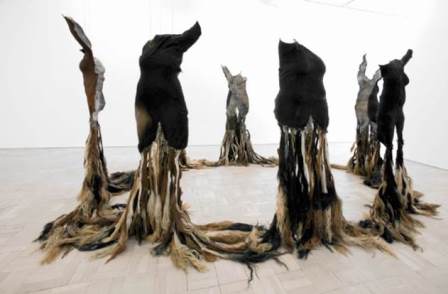XXII International Congress of Historical Sciences
23-29 August, 2015, Jinan, China
Round Table 14
Thursday, 27 August / 9 am - 12 pm
Conference Room on the 5th Floor, Nanjiao Hotel
Abstracts
Ewa Domanska (Adam Mickiewicz University, Poznan/Stanford University)
Contemporary Art and the Future of History
My paper circulates around the following topics: new approaches to thinking about the past in the humanities and social sciences; the relevance of art to renewal of historical thinking; examples of the contemporary art (Wenda Gu’s United Nations Art Project and Nandipha Mntambo’s Europa and cowhide sculptures) and the relevance of these artists’ techniques and ideas to the development of post-anthropocentric, post-Western and post-secular knowledge about the past. Analysis of Gu’s and Mntambo’s art would illustrate four basic assumptions: the first follows current discussions on the relationship between social justice and epistemological justice, a critique of Western cognitive imperialism and a problem of “epistemological dependency” of non-western scholars; the second claims that there is a need for realistic, responsible (local or micro) utopias – alternative scenarios of the future, that might be developed with the help of various ways of knowing (the past); these new ways of knowing the past would be based not only on closely related humanities, social sciences and life sciences and natural sciences (“radical interdisciplinarity”) – which is to say, Western type of historical knowledge, but would also include various indigenous ways of knowing; the fourth assumption follows Susan Sontag’s statement that “each work of art gives us a form or paradigm or model of knowing something, an epistemology,” and claims that analysis of various types of artistic objects and activities might help us to build an inclusive epistemology of the past more appropriate for the planetary condition than history understood as a specific kind of knowledge of the past that emerged within the greco-judeo-christian tradition.
Andrea Giunta (University of Texas at Austin, University of Buenos Aires and CONICET)
Nation and Repression. Patriarchal States in Contemporary Latin American Art
The timeframe habitually taken into consideration as the starting point for the contemporary era is marked by global events of undeniable impact: the end of the Second World War or the end of the Cold War, according to point of view. Nevertheless, in terms of Latin American historical events, the wave of dictatorships had a much greater, more direct impact in terms of delimiting changes in the underlying conceptual vectors made manifest in discourse, ideology and symbolism. The dictatorships and their systems of repression made the authoritarian construction of patriarchal South American states evident. During the seventies and eighties, artists in Brazil, Chile and Uruguay deconstructed their countries’ foundational myths in their work. Cildo Meireles took on the historical figure Tiradentes, the miners’ uprising hero; Eugenio Dittborn deconstructed the myth of a white nation configured by representatives of the Chilean nation; Juan Dávila analysed the patriarchal condition of Latin American heroes; and Nelbia Romero investigated the relationship between the dictatorship and the genocide of the Charrúa indigenous people. These artists chose to handle the foundation of different imagined communities in order to question the paradigms of violence and oppression involved. They did so by way of installations, making use of the intellectual and emotional structures they enable. They employed the body, performance, dance, ritual, violence and queer interventions to de-structure normalized representations. Carried out in urban spaces or utilizing the state postal system, these artists’ works had a strong impact on the public, generated debate and even led to diplomatic tensions. Their works operated like ideological laboratories, articulating forms able to de-structure power’s discourse. The four cases analysed here allow us to see how these works were able to contradict the stabilizing forces of the marketplace and demonstrate the power inherent in art images. Our hypothesis sustains that symbolic representations produced in the terrain of art are essential to an understanding of how Latin American states have been reformulated in the post-dictatorship period along inclusive, democratic lines. These poetic expressions that disassembled both bodies and discourse operated as active, symbolic laboratories, transforming states’ ideological models in the post-dictatorship era.
Yang Jiashen (Shandong University, Jinan, China)
History and culture in Chinese characters
Compared with the written words from other countries, Chinese characters have a notable characteristic, its pictographic nature. Many Chinese history and culture are reserved directly or indirectly in these characters. Therefore, they become important materials in the research of Chinese history and culture. And at the same time, calligraphy, in the most direct visual form, develops into a specific art form of China, Asia and even the world. In this regard, alphabetic writing words seldom have the same function as Chinese characters do.
Based on the pictographic nature, Chinese characters possess an unparalleled advantage of containing information of history, culture and art all in one. After overcoming the computer input methods barrier, its advantages forebode a promising future in the global written word fields. The advantages of Chinese characters can be embodied in the aspect of being easily perceived just by means of forms, especially the ancient forms, that is why they are still holding the stage of calligraphy and loved by many scholars and artists home and abroad.
Claudia Mandel Katz (University of Costa Rica)
Violence, memory and the indigenous’ body in Guatemala
The female body is constituted as a space from which to undermine patriarchal edges or boundaries: gender, class, culture, identity. To the extent that it functions as a text within a specific socio-historical space in relation to dominant codes, the female body becomes a web of power relations, of political praxis.
I propose to analyze the performance of the Guatemalan artist Regina Galindo titled “While they are still free,” 2006, which reflects on the problem of violence against women in Guatemala. In that action, the eight-month-pregant artist, remains tied to a bed by umbilical cords. This action tries to remind of the systematic violation of indigenous women pregnant during the armed conflict in Guatemala, as part of a bloody military strategy that intended for women to abort and thus hinder the survival of indigenous peoples. In this performance, based on testimonies of the attacked women taken from the book Memory of Silence (1999), the artist becomes the scene of constant conflict between the power of tortures, rapes and murders and her own body that denounces. Thus, Galindo's body, carrier of the identities of raped indigenous women, becomes the symbolic support of collective identity and memory of an entire people. This active memory, which redefines the past and demands justice, is a memory of the difference, a memory that operates from the margins, from the edges, attacking the centrality of the "official story". The insertion of Regina Galindo's body in contemporary cultural scene centralizes a performative body which can produce from the edges, from the margins, a new rationality.
Nandipha Mntambo (artist, Johannesburg, South Africa)
Greek mythology in Nandipha Mntambo’s work
The presentation will focus on the representation of the body within Nandipha Mntambo’s practice. She will discuss how her work has been influenced by Greek mythology as well as the notion of seduction and repulsion which is emblematic of her use of cowhide. The material enables her to subtly deal with representation, myth, monuments and seduction as a tool to interrogate the viewer in what they readily denounce in public. Gender roles and anthropomorphism in Greek mythology plays itself more when looking at the bull which she has used in her photographs, video works and bronze sculptures such as: The Rape of Europa, Narcissus, Europa, Sengifikile, Zeus, Ukungenisa and her most recent video work Marie Sara.
Þóra Pétursdóttir (The Arctic University of Norway, Tromsø)
Aesthetics of ruination and heritage value
Programs of heritage management and conservation may be seen as challenging conventional modern systems of value and care, focusing partly, or even mostly, on ruined things – things that for some reasons have been abandoned or discarded and thus excluded from other/past systems of value. Nevertheless, promotion to the category of heritage generally involves specific cosmetic transformations and material maneuvering, which may be argued to reflect an underlying paradox of heritage management; namely, the care for ruins but repugnance toward ruination. The aesthetic value of the ruin is a topic that long has occupied both scholars and artists, and the current interest for modern ruins (evident, for example, in the fields of photography and archaeology of the recent past) may be seen as the contemporary manifestation of this genre. A less considered topic, however, is the aesthetics of ruination – the lure of active decay, and its physical affect on encounter. In this paper I will seek to scrutinize dominant conceptions of ‘heritage value’, and the current associations between ruination and loss. With reference to recent and ongoing research on ruins of recent pasts I will ask; what is it in ruination that concurrently attracts and repulses us? And, how do these very tangible or physical aspects impinge on our experience of ruins, and thus our heritage value? Valuing ruination seems incompatible to the currently dominating heritage discourse. But, is there room for a different kind of heritage? And, what kind of ruin aesthetics would it entail?


